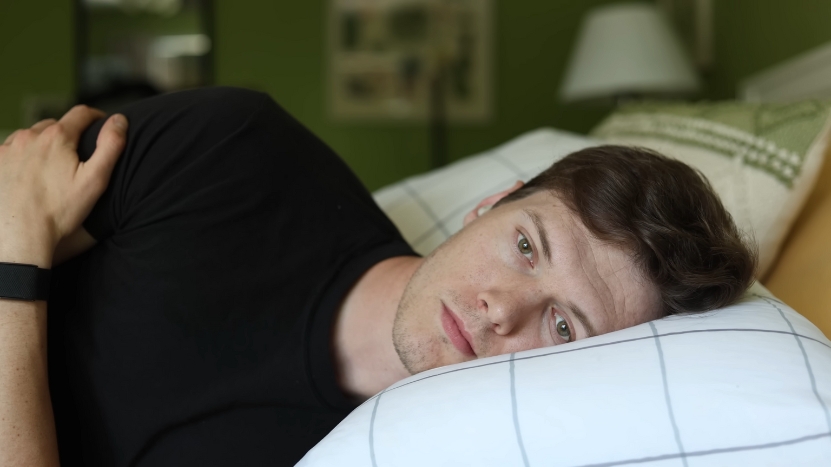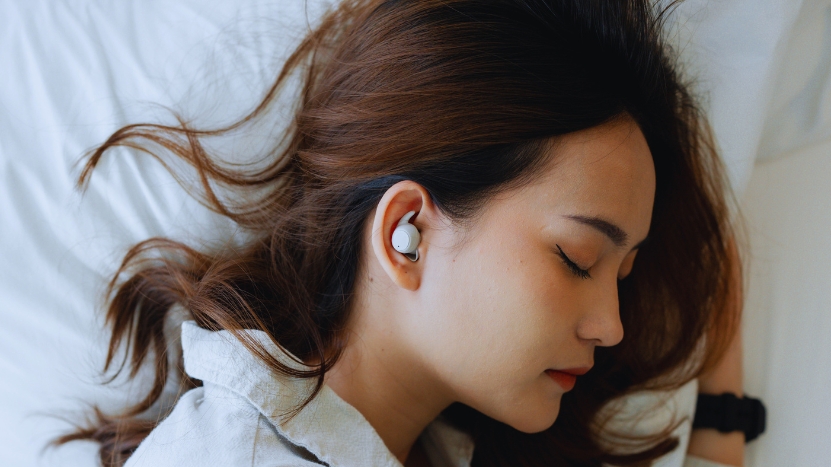Sleeping with earbuds in is not inherently dangerous if done occasionally, but consistent use carries measurable health risks.
According to the American Academy of Otolaryngology, prolonged in-ear device use during sleep can contribute to increased earwax impaction, a higher chance of outer ear infections, and potential hearing damage if the volume is too high for extended periods.
The safest approach is limiting earbud use to short-term situations such as travel, occasional noisy nights, or when using specialized sleep-optimized designs.
Nightly use with standard earbuds, especially noise-isolating in-ear models, increases the likelihood of discomfort, infection, and reduced auditory safety awareness.
Why People Sleep with Earbuds in the First Place

Many people reach for their earbuds before bed to listen to calming music, podcasts, white noise, or guided meditation. For light sleepers or those with noisy surroundings, they can be a quick fix to block out disturbances. Others use them to help with tinnitus or to mask a partner’s snoring.
However, while the short-term benefits are clear, better relaxation and possibly quicker sleep onset, experts highlight that the ear canal is not designed for prolonged, compressed contact with a foreign object.
Main Risks of Sleeping with Earbuds
Even if you use high-quality, comfortable earbuds, certain risks increase the more you sleep with them.
1. Ear Infections
Your ear canal is a warm, slightly moist environment. Trapping earbuds inside overnight can limit ventilation, encourage bacterial growth, and push earwax deeper.
Over time, this can lead to otitis externa (outer ear infection) or more serious middle-ear infections.
2. Skin Irritation and Pressure Sores
Long hours with earbuds pressing against your skin can cause redness, tenderness, or even pressure sores — especially for side sleepers whose ears get compressed between the pillow and the earbud.
3. Hearing Damage
Falling asleep while playing loud audio increases your risk of noise-induced hearing loss. The World Health Organization advises keeping listening levels under 60% of maximum volume and limiting continuous listening to under an hour. Sleeping all night with moderate-to-high volume exceeds safe exposure levels.
4. Earwax Impaction
Earbuds can push wax deeper into the canal, making it harder to remove and potentially affecting hearing.
5. Safety and Awareness
While rare, blocking environmental sounds completely may make it harder to wake up in an emergency, such as during a smoke alarm.
Risk Comparison
Risk Factor
How Serious?
More Likely If…
Preventive Tip
Ear Infections
Moderate–High
Earbuds are worn nightly, with no cleaning
Clean earbuds daily, rest your ears some nights
Skin Irritation
Low–Moderate
Side sleeper, tight fit earbuds
Choose softer silicone tips
Hearing Damage
High if volume is loud
Audio plays all night at >60% volume
Use volume limit settings
Earwax Impaction
Moderate
History of wax buildup, poor ear hygiene
See an audiologist for cleaning
Reduced Safety Awareness
Low
Fully noise-canceling earbuds
Use ambient sound mode
Safer Options for Nighttime Listening
View this post on Instagram
For those who want audio before or during sleep but prefer to avoid the risks of traditional earbuds, several safer alternatives exist. Sleep-specific headphones are one option. These feature flat, fabric-covered speakers built into a headband, which sit over the ears without entering the ear canal.
They are washable, breathable, and put far less pressure on the ears, making them a good choice for side sleepers. The trade-off is reduced noise isolation compared to in-ear earbuds.
Another option is pillow speakers, small, flat devices placed under or inside the pillow. They deliver sound without touching the ear at all, eliminating canal irritation and reducing infection risk. However, because they are not fully isolated, the sound may be faintly audible to others in the room.
Bone conduction headsets provide a different approach by transmitting sound through the cheekbone, leaving the ear canal completely open. This maintains environmental awareness and avoids the issues linked to prolonged in-ear use. On the downside, they are bulkier and may shift position during sleep, especially if you move around a lot.
Lastly, white noise machines remain one of the healthiest long-term solutions. They fill the room with a consistent masking sound, blocking environmental noise without any direct ear contact. While this makes them ideal for ear health, they are less portable than other devices and offer less control over the specific audio content.
Device Comparison
Device Type
Ear Canal Contact
Noise Isolation
Infection Risk
Long-Term Comfort
In-Ear Earbuds
Yes
High
High
Low for side sleepers
Sleep Headband
Minimal
Moderate
Low
High
Pillow Speaker
None
Low–Moderate
None
High
Bone Conduction Headset
None
Low–Moderate
None
Moderate
White Noise Machine
None
Room-based
None
Very High
Best Practices If You Must Sleep with Earbuds
@shoandtech Apparently this is a thing? Do you wear earbuds while you sleep? #soundcore #sleepa10 #tech #shoandtech ♬ Shipyard Sample – Official Sound Studio
If avoiding earbuds entirely is not an option, certain habits can lower the health risks. Experts recommend keeping the listening volume low, ideally under 50 decibels for continuous playback, and avoiding nightly use, limiting it to two or three nights per week.
Regular cleaning is essential, and wiping the earbuds with isopropyl alcohol before each use can significantly reduce bacterial buildup.
Selecting soft silicone or memory foam tips helps minimize pressure points, especially for side sleepers, while alternating ears or using only one earbud at a time can reduce prolonged canal contact.
It’s also wise to check regularly for early signs of irritation, such as redness, swelling, or itching. For frequent users, scheduling routine ear health examinations with an audiologist or ENT specialist can help detect and address issues before they become serious.
Bottom Line
Sleeping with earbuds in is generally safe on occasion, but regular nightly use increases the risk of ear infections, hearing loss, and discomfort, especially for side sleepers.
The phases of the Moon can subtly influence sleep quality, which might make some people more inclined to use audio at night.
If you need audio to fall asleep, consider switching to sleep-specific headphones, pillow speakers, or white noise machines for a healthier, more sustainable solution.

